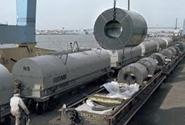Shipping and Logistics

Logistics Report July 2016
Written by Sandy Williams
July 23, 2016
Each month Steel Market Update looks at shipping conditions on the seas, rivers, rails and highways. July freight volumes were down somewhat in the first half of July for cargo moved by rail and truck. Barges on America’s rivers are seeing an uptick in rates due to several lock closures. Seaborne shipping is seeing a rise in rates as grain exports pick up and vessel overcapacity begins to ease.
Seaborne Shipping
Freight rates are increasing for the shipping industry, according to the latest report by MID-SHIP. All of the indices that make up the Baltic Dry Index were rising at the beginning of the month with the BDI at 748 on July 18. Since then the Index has declined again, registering at 718 as of July 22. Strong grain exports in South America and now in the North America and the Black Sea have created demand opportunities for the seaborne market.
The oversupply of vessels is beginning to ease due to scrapping of older vessels and a slowdown of new ones entering the market. Scrapping of vessels surpassed new vessels entering the Cape and Panamax markets in the first five months of 2016; new versus scrapped Handysize vessels were mostly equal. Rates in Supra and Ultramax sectors remained firm, said MID-SHIP, despite scrapping numbers not keeping pace with new vessel entries.
MID-SHIP considers Brexit a “non-event to dry bulk trade” which is transacted in U.S. dollars. The market will more likely be affected by the strengthening American economy, conditions for oil exporting countries, and the outcome of the U.S. presidential election on trade.
Rivers
The Army Corps of Engineers has announced that complete closure of the Industrial Locks will take place on August 1 and will last at least 120 days while a gate is replaced. Navigation will be directed through Baptiste Collette for barges moving between the Mississippi River and points along the Eastern Gulf coast. MID-SHIP advises that delays should be expected as the detour is long and barges will have to cross open water that can be impacted by weather conditions.
Other lock closures are planned for the Arkansas River, Tombigbee River, Tennessee River, Upper Mississippi, and Ohio River. Plan for shipping delays for the rest of the summer. Grain shipments are likely to cause a seasonal increase in spot rates. MID-SHIP notes, “It remains to be seen how significantly demand will outweigh supply of available barges in the coming season, particularly with the backdrop of relatively weak import bulk commodities.”
Rail
The Association of American Railroads reports that U.S. weekly rail traffic for the week ending July 9 declined 17.2 percent year-over-year to 442,113 carloads and intermodal units. Carloads totaled 226,615, down 16.5 percent. Intermodal volume decreased 17.9 percent to 215,498 containers and trailers.
Trucking
The American Trucking Association reported the ATA Truck Tonnage Index fell 1.5 percent in June, following a revised gain of 2.9 percent in June. Tonnage has been on a seesaw pattern said ATA chief economist Bob Costello. On a month-to-month basis, he said, tonnage has been down in in three of the last four months.
“Looking ahead, I expect the freight environment will remain choppy,” said Costello. “The good news for trucking is we are the most diverse mode of all freight transportation sectors between industrial and consumer freight. We are currently benefiting from the consumer side while being hurt on the industrial side. And of course we still have the inventory glut that is weighing down tonnage.”
Flatbed demand was down following the Independence Day holiday. During the week July 10 through July 16, the load-to-truck ratio fell 14 percent, from 15.6 to 13.4 loads per truck. National flatbed rates increased 4 cents per mile to $1.89 per mile during the period. The week’s national average rate was 6 percent lower than the average rate for June. Rates were highest in the Baltimore area at $3.01 per mile, $2.37 per mile in the Midwest, and lowest in Los Angeles at $1.85 per mile. The average price for diesel during the period was down one cent to $2.40 per gallon.
June’s data shows national flatbed load availability rose 11 percent in June compared to May, according to DAT Solutions. Capacity was up 3.3 percent for a 7.5 percent in increase in the national-load-to-truck ratio to 18.1 loads per truck. The national average for flatbed rates was up 3 percent from May to $1.95 per mile.
A new study by DAT showed 63 percent of drivers are detained more than three hours for loading and unloading. According to the survey of 257 carriers and owner-operators, 54 percent of drivers wait between 3 to 5 hours at shipping docks while another 9 percent said the average wait is more than 5 hours. The extended wait is a problem for trucking companies that lose revenue from potential loads they cannot accept due to shipping dock delays.

Sandy Williams
Read more from Sandy WilliamsLatest in Shipping and Logistics

Wittbecker on Aluminum: US-China trade war clobbers cross-Pacific trade
Container shipping lines have sharply increased blank sailings on Transpacific routes in response to escalating trade tensions between the US and China.

Volvo plans to lay off up to 800 workers at US truck plants
The company cited uncertainty about freight rates and demand, regulatory changes and the impact of tariffs.

Trump signs executive order aimed at making US shipbuilding ‘great again’
President Trump on Wednesday signed an executive order meant to breathe new life into American shipbuilding and curb Chinese dominance in the sector.

Great Lakes iron ore trade fell again in March
Recall that shipments also saw a sharp decline in January.

Longshoremen ratify contract with maritime alliance
Nearly 99% of ILA members voted in favor of a new labor deal with the United States Maritime Alliance that covers workers at ports on the Atlantic and Gulf coasts.
